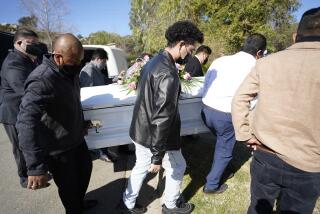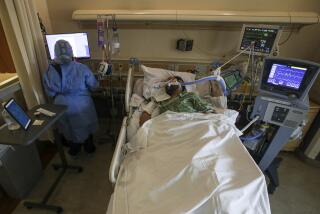Science / Medicine : Agency Improves Hospital Mortality Data--But It’s Still Tough for Consumers : Health: Report on Medicare patients by the Health Care Financing Administration has yet to be packaged in a way to be useful to consumers.
- Share via
The latest version of the federal government’s Medicare hospital mortality information demonstrates that the U.S Health Care Financing Administration has markedly improved the statistical techniques used in preparing the massive study.
For example, it has taken into account the percentage of emergency cases and nursing home transfers among a hospital’s cases. As a result, the report, which was released last month, provides more reliable information about the care of the elderly and disabled at the nation’s hospitals. For this and other reasons, its value to hospital officials and regulatory agencies has grown.
But the government still has a ways to go in making its data useful and understandable for the average consumer who seeks health care. This could be accomplished by addressing specific medical diagnoses and procedures rather than the broad “diagnostic categories” currently defined by the Health Care Financing Administration and also by more sophisticated interpretation of the numbers.
Mortality rates are only one of many measures of hospital performance. But the review of deaths to determine which ones might have been preventable can often lead to improvements in the quality of care.
The statistics in the report reflect the percentage of a hospital’s Medicare patients who died within 30 days of being admitted to the hospital, whether as hospital patients or after discharge. This actual mortality rate is compared to a hospital’s predicted mortality rate, which takes into account characteristics of patients that predict their relative risk of dying, such as age, sex, chronic diseases and previous hospitalizations.
For example, the report highlights the differences in Medicare death rates at Los Angeles County hospitals. Between 1986 and 1988, the death rate at Martin Luther King Jr./Drew Medical Center was 54.4% higher than predicted, according to an analysis of the Health Care Financing Administration data by Michael Pine and Associates Inc., a Chicago health care consulting firm, that was made available to The Times. By comparison, the death rate at County-USC Medical Center was 9.3% lower than predicted.
Such statistics for 1987 helped to trigger a federal study of King. The government has since ordered the hospital to correct a wide range of deficiencies.
In general, California’s academic medical centers have better-than-predicted mortality rates. UC San Francisco and UCLA have mortality rates that are about 25% lower than expected, while UC San Diego is 11% under its predicted rate.
But the report contradicts the conventional wisdom that university teaching hospitals invariably care for the sickest patients, while health maintenance organizations care for elderly patients who are less ill.
In fact, typical Medicare patients at UCLA, UC Irvine and UC San Diego appear to be at significantly less risk of dying when they enter the hospital than the average Medicare patient. By comparison, typical Medicare patients at Kaiser Foundation Hospitals have an average risk of death.
Comparisons of the relative risk of dying at different hospitals can help to focus the activities of state and federal regulatory agencies. They may wish to concentrate their efforts on the hospitals whose patients have the greatest risk of dying. These hospitals are those, such as King, with both a higher-than-predicted mortality rate and sicker-than-average Medicare patients.
The Health Care Financing Administration, however, could increase the usefulness of the annual hospital mortality information further by making the reports easier to understand.
For instance, the agency provided statistics for overall mortality and 16 broad “diagnostic categories.” But the federal government could also provide mortality information on specific diagnoses and surgeries that are common in the elderly, such as heart attacks, heart bypass surgery and prostate surgery.
The agency’s report compares a hospital’s actual mortality rate to “a range for predicted mortality.” Instead, the government could state what the predicted mortality rate was, as Pine and Associates did in their analysis of the agency’s data. This is almost always done when similar statistics are published in medical journals. National and statewide mortality rates, which are not included in the report, could also be provided.
To increase the statistical precision of the report, the agency could also combine data for several years, as Pine and Associates did. Unless this is done, the report will have very limited value for small hospitals or those with small numbers of particular types of Medicare patients.
The Health Care Financing Administration has stated that it is committed to improving the data. In a written statement released last month, officials said they expect the 1990 report to “reflect progress toward more accurate and useful information for hospitals, physicians and consumers alike.”
MEDICARE DEATH RATES
Medicare mortality rates for selected California hospitals as compared to their predicted death rates between 1986 and 1988, according to an analysis of U.S. Health Care Financing Administration data by Michael Pine and Associates, Inc., a Chicago health care consulting firm.
The death rate is the percentage of a hospital’s Medicare patients who died within 30 days of being admitted, whether as patients or after discharge. The national average 30-day mortality rate is about 12%. Hospitals listed in bold type had statistically significant high or low mortality rates.
HOSPITAL PATIENTS PATIENT DEATH RISK RATE Academic Medical Centers Loma Linda Univ Med Center 10,848 .96 10.5% Stanford Univ Med Center 11,840 .96 10.8% UC Davis Med Center 5,245 1.03 12.4% UC Irvine Med Center, Orange 2,642 .84 9.7% UCLA Med Center, Westwood 9,023 .86 7.6% UC San Diego Med Center 4,772 .82 8.8% UC San Francisco Med Center 8,696 .93 8.1% Los Angeles County Hospitals Harbor-UCLA Med Cent, Torrance 2,049 1.13 15.2% LA County-USC Med Center 3,994 .97 10.5% ML King Jr./Drew Med Cent, LA 1,323 1.23 22.7% Oliveview Med Center, Sylmar 351 1.13 13.4% LAC High Desert Hosp, Lancaster 258 1.09 14.3%
HOSPITAL % HIGHER OR LOWER THAN EXPECTED Academic Medical Centers Loma Linda Univ Med Center -8.5% Stanford Univ Med Center -5.7% UC Davis Med Center +0.2% UC Irvine Med Center, Orange -3.2% UCLA Med Center, Westwood -25.6% UC San Diego Med Center -11.0% UC San Francisco Med Center -26.6% Los Angeles County Hospitals Harbor-UCLA Med Cent, Torrance +12.6% LA County-USC Med Center -9.3% ML King Jr./Drew Med Cent, LA +54.4% Oliveview Med Center, Sylmar 0.0% LAC High Desert Hosp, Lancaster +10.5%
NOTES: “Patient risk” is a measure of the relative risk of dying for a hospital’s patients as compared to national average. A value of “1” is average. A value over “1” is above average. A value under “1” is below average.
The “% Higher” or “% Lower” than expected statistic is a comparison of a hospital’s actual and predicted mortality rates. The predicted mortality rate takes into account characteristics of individual patients, such as age, sex, major diagnosis, other chronic illnesses, prior hospitalizations, emergency admissions and nursing home transfers.






